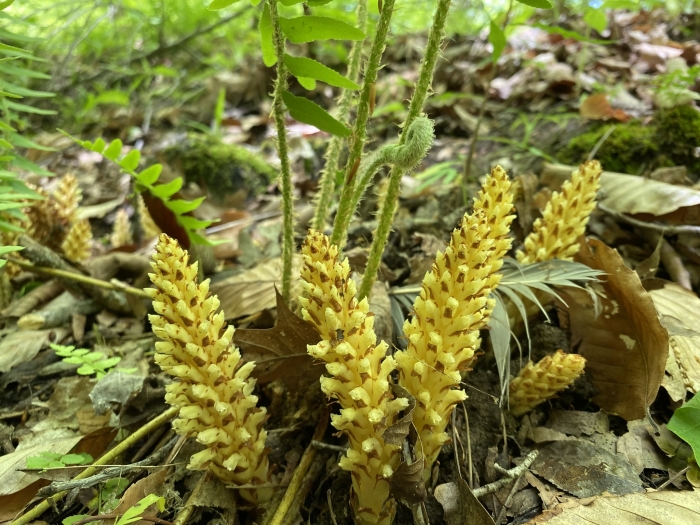American Cancer-Root
(Conopholis americana)
American Cancer-Root (Conopholis americana)
/
/

William D. Leodinh
CC BY 4.0
Image By:
William D. Leodinh
Recorded By:
Copyright:
CC BY 4.0
Copyright Notice:
Photo by: William D. Leodinh | License Type: CC BY 4.0 | License URL: http://creativecommons.org/licenses/by/4.0/ | Rights Holder: William D. Leodinh | Publisher: iNaturalist | Date Created: 2021-05-11T18:18:25Z |


















Estimated Native Range
Summary
Conopholis americana, commonly known as American cancer-root, is a perennial herb that is parasitic on the roots of oak and beech trees. It is native to rich, deciduous forests and wooded ravines throughout eastern North America. This unique plant lacks chlorophyll and therefore does not photosynthesize; instead, it derives all its nutrients from its host plants. American cancer-root typically reaches 4-8 inches in height and features a yellowish, cone-shaped inflorescence that emerges above ground in the spring. The inflorescence is made up of tiny, scale-like structures instead of true leaves. It is an intriguing plant for its unusual mode of nutrition and its role in forest ecosystems.
American cancer-root is not commonly cultivated due to its parasitic nature and specific host requirements. However, it can be of interest in native plant gardens or educational settings where its unique biology can be demonstrated. It requires the presence of host trees and is not suitable for general garden cultivation. In its natural setting, it spreads by reseeding. While not a plant for traditional horticultural uses, it can be a conversation starter and an educational specimen in the right context.CC BY-SA 4.0
American cancer-root is not commonly cultivated due to its parasitic nature and specific host requirements. However, it can be of interest in native plant gardens or educational settings where its unique biology can be demonstrated. It requires the presence of host trees and is not suitable for general garden cultivation. In its natural setting, it spreads by reseeding. While not a plant for traditional horticultural uses, it can be a conversation starter and an educational specimen in the right context.CC BY-SA 4.0
Plant Description
- Plant Type: Herb
- Height: 0.5-1 feet
- Width: 0.5-1 feet
- Growth Rate: Slow
- Flower Color: Brown, Cream
- Flowering Season: Spring, Summer
- Leaf Retention: Deciduous
Growth Requirements
- Sun: Part Shade, Full Shade
- Water: Medium
- Drainage: Medium
Common Uses
Deer Resistant, Low Maintenance
Natural Habitat
Native to rich, deciduous forests and wooded ravines throughout eastern North America
Other Names
Common Names: American Squawroot, Bear Corn, Squaw-Root
Scientific Names: , Conopholis americana, Orobanche americana,
GBIF Accepted Name: